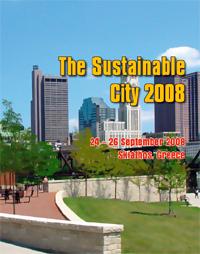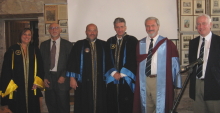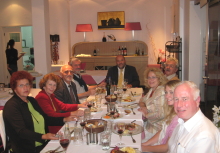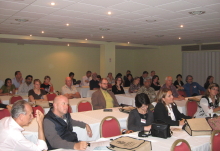Fifth International Conference on Urban Regeneration and Sustainability
![]() 24 - 26 September 2008
24 - 26 September 2008
Skiathos, Greece
Overview
 The 5th International Conference on The Sustainable City – Urban Regeneration and Sustainability took place recently on the Greek Island of Skiathos, organised by the Wessex Institute of Technology (WIT), UK; the University of Siena, Italy; and the University of Thessaly, Greece. The Meeting was also sponsored by WIT Transactions on Ecology and the Environment and the International Journal of Sustainable Development and Planning, both published by WIT Press.
The 5th International Conference on The Sustainable City – Urban Regeneration and Sustainability took place recently on the Greek Island of Skiathos, organised by the Wessex Institute of Technology (WIT), UK; the University of Siena, Italy; and the University of Thessaly, Greece. The Meeting was also sponsored by WIT Transactions on Ecology and the Environment and the International Journal of Sustainable Development and Planning, both published by WIT Press.
The aim of the conference was to address the many inter-related aspects of urban environment from transport, mobility and architecture to social exclusion and crime prevention. Urban areas produce a series of environmental problems arising from the consumption of natural resources and the consequent generation of waste and pollution. These problems contribute to the development of social and economic imbalances. All these problems, which continue to grow in our society, require the development of new solutions.
The Sustainable City 2008 conference follows four very successful meetings, held in Rio (2000), Segovia (2002), Siena (2004) and Tallinn (2006).
Opening Addresses and the Prigogine Award

Audience at the Prigogine Award Presentation
Professor Carlos Brebbia opened the ceremony in the name of his Institute and as a representative of the Award Committee for the Prigogine Medal. He started by thanking the Abbott, Pastor Igoumenos Angelos Lussaris for allowing the Conference the use of the main hall in the Monastery to hold the Ceremony. He also expressed the gratitude of the organisers to Skiathos Island Municipality, and to its Mayor, Nikos Plomaretis.
Professor Brebbia then opened the proceedings by referring to the importance of the Prigogine award, as follows:
“The Prigogine Medal was established in 2004 by the University of Siena and the Wessex Institute of Technology to honour the memory of Professor Ilya Prigogine, Nobel Prize Winner for Chemistry, and in the words of Enzo Tiezzi ‘the greatest scientist of the 20th Century’.
“Ilya Prigogine was born in Moscow in 1917, and obtained his undergraduate and graduate education in chemistry at the Free University in Brussels. He was awarded the Nobel Prize for his contribution to non-equilibrium thermodynamics, particularly the theory of dissipative structures. The main theme of his scientific work was the role of time in the physical sciences and biology. He contributed significantly to the understanding of irreversible processes, particularly in systems far from equilibrium. The results of his work have had profound consequences for understanding biological and ecological systems.
“In the words of Prigogine, ‘The development of a theory permits us to distinguish various levels of time; time as associated with classical or quantum mechanics, time associated with irreversibility and time associated with history through bifunction. I believe that this diversification of the concept of time enables a better integration of theoretical physics and chemistry with disciplines dealing with other aspects of nature.”
Prigogine’s ideas established the basis for ecological systems research. The Prigogine Medal to honour his memory is awarded annually to a leading scientist in the field of ecological systems. All recipients so far have been deeply influenced by the work of Prigogine, to the point that they could justly be called his disciples.
The recipient of the first medal in 2004 was Professor Sven Jorgensen of the Danish University of Pharmaceutical Sciences. He is well known for this work in Ecology, particularly in systems modelling, ecological engineering, environmental sciences and environmental management of aquatic systems.
“Professor Jorgensen serves on many important committees and as Editor of many scientific publications. He has published more than 300 papers and 60 books. His Medal was awarded by the Rector of the University of Siena who called a special congregation in their Aula Magna.
“Professor Enzo Tiezzi received the 2005 Medal at the University of Cádiz during an academic ceremony presided over by the Rector of that Institution. Professor Tiezzi studied at the University of Florence where he developed an interest in the then novel field of magnetic resonance and worked on the first MR prototype machine built at that university.
“After teaching at Cagliari University, he won a Fullbright Scholarship to Washington University, where he continued working on MR under Professor Sam Weissman of the Physics Department and Professor Barry Commoner of the Department of Biology. This collaboration resulted in several Seminar papers on pioneering development of MR.
“Professor Tiezzi taught Physical Chemistry at Florence for several years before being appointed at the University of Siena where he is Full Professor of Physical Chemistry. His outstanding scientific career has been matched by a strong involvement in environmental and social issues, reflecting his deepening commitment to ecology and Prigogine’s ideas. Professor Tiezzi, in addition to numerous papers, has published more than 20 books dealing with scientific topics, as well as humanities and poetry.
“Bernard Patten, recipient of the 2006 Medal, is Regent Professor of Ecology at the University of Georgia in the USA. He is a Systems Ecologist and Ecological Modeller interested in the applications of mathematical theory to ecosystems. He formulated a well known environmental theory called “environ theory and analysis” that permits the use of network mathematics to represent and analyse ecosystem networks.
“Professor Patten’s publications include many papers on a variety of ecological topics especially main fresh water and wetlands ecosystems.
“Robert Ulanowicz, recipient of the 2007 Medal is Professor at the University of Maryland, at the Chesapeake Biological Laboratory. He is a Chemical Engineer by training who specialised on Ecosystems Theory with outstanding results in the field of Complex Ecology. His scientific contributions are renowned in Network Analysis, Information Theory in Ecology, Thermodynamics in Ecology and Causality in Evolving Systems.
“Another area of interest for Professor Ulanowicz is the dialogue between science and religion.
“Professor Ulanowicz has published more than 150 scientific papers in international journals, and several books, as well as being a member of the editorial board of several international journals.”
Professor Brebbia’s words were followed by those of Dr William Blain who, as Deputy Director of Wessex Institute of Technology, is responsible for the organisation of academic events, including those connected with the Prigogine Medal. Dr Blain’s address was as follows:
“Ioannis Antoniou is Professor of Analysis and Statistics and Head of the School of Mathematics at the Aristotle University of Thessalonica.
“He graduated from the Physics Department of the University of Athens. After Graduation he worked in the Greek Ministry of the Environment on atmospheric pollution measurements and statistical analysis and went to Brussels for his PhD research, where Ilya Prigogine was one of his PhD advisors. His Doctorate Thesis on Relativistic Chaos and Probabilistic Analysis of Complex Systems was the beginning of a fruitful collaboration and friendship with Ilya Prigogine. This work led to a new infinite dimensional algebra which extended the conventional Poincaré algebra of relativity to the explicit construction of a non-unitary transformation relating the non-wave equation with the telegraphist equation. Recently it was shown that this algebra provides a nice counter-example in the theory of non commutative algebras and that our extension of how the Time Operator can be applied to the diffusion equation and even to more general stochastic processes. The age eigenstates provided a new representation of the solution of the diffusion equation where the key issue of evolutionary processes admitting Internal Time is Innovation. Complex systems are qualified as the ones producing new information and innovation.
“The relations of the Time Operator with what was known as subdynamics in the 1980’s was the second task that Ilya Prigogine suggested to Ioannis Antoniou after his PhD. Following a remark by J. Jauch that subdynamic expressions are meaningless in the Hilbert Space formulation, it was found that they acquire meaning in suitable extensions of the evolution operators beyond the Hilbert Space framework, to suitable locally convex spaces known also as Rigged Hilbert Spaces. In this framework resonances and decaying states appear as generalized eigenvalues and eigenfunctions of the evolution operators. In fact what underlies subdynamics is spectral theory of operators beyond the Hilbert Space.
“These extensions gave no new information for stable and/or integrable systems, but for unstable and/or non-integrable systems they have proved to be intrinsically probabilistic and irreversible. This means that the statistical evolution cannot be reduced to trajectories or wave functions and that the statistical evolution is not a group, but splits naturally into two distinct semigroups. The future semigroup should be compatible with our observations, i.e. should correspond to entropy increase. In this framework irreversibility and probability prove to be intrinsic properties of complex systems and the relation with the Time Operator becomes clear. The age eigenstates are simply related to the resonance states by a generalized Fourier transform. This is just a generalization of the well-known position and momentum representations in quantum mechanics. Examples were found, however, where one can construct the Time Operator of the age eigenstates where the extended spectral decomposition does not exist for analytic functions. This situation, like the position representation, is not equivalent to the momentum representation. All this work provided a new mathematical formulation from the intuitive ideas of Ilya Prigogine which can be summarized with the three keywords he liked to use during his seminars: Irreversibility, Instability, Probability.
“The discussion of Irreversibility demands an extension of our mathematical knowledge. These extensions gave rise to a new kind of fuzzy logic of classical and quantum complex systems and provided, moreover, new statistical tools for the analysis and simulation of complex systems. New results have been obtained in several applications: the development of probabilistic control strategies for complex systems, the development of probabilistic filters for the reconstruction of images obtained from Optical Coherence Tomography, remote sensing, 3-D data, and analysis of rare events originating from earthquakes or the stock market.

Prof. I Antoniou (3rd from left)
“Professor Antoniou’s work was carried out at the International Solvay Institute of Physics and Chemistry from 1982 until the passing away of Ilya Prigogine in May 2003. Ioannis Antoniou was appointed Deputy Director of the Solvay Institutes in 1994 where he stayed until 2004 when he returned to Greece. Inspired by the vision of Ilya Prigogine, Professor Antoniou is now involved in the statistical analysis of complex networks related to Biomedical Problems and the Internet, as well as in mathematical problems of Complexity.
“Thanks to Ilya Prigogine,” Professor Antoniou has explained, “the cleavage between the two cultures does not appear any more. In the new vision of the Universe as an ongoing construction, we are active participants and not passive gears in the cosmic mechanical clock. Prigogine however, was not satisfied from these developments. He felt that we are simply at the end of the prehistory of Science. The new formulation of Complexity paved the way, but did not answer the questions:
- What is the primordial instability which gave rise to the Universe?
- What is Life?
- What are the transition mechanisms which give rise to Organisms from the genotype?
- What features of Complexity are able to support Mind and Consciousness?
- What is the Complexity of the World Wide Web?
- How to design our life in a sustainable way based on the Complexity of Socio-Economic Processes and Ecosystems?
Professor Michael Zouboulakis, Vice-Rector of the University of Thessaly then proceeded to award the Prigogine Medal to Professor Ioannis Antoniou for his contribution to the understanding of ecological systems.
Professor Carlos Brebbia then invited Professor Antoniou to deliver his special keynote address, a summary of which follows.
Professor Antoniou started by discussing the legacy of Prigogine regarding time and complexity. He realised that time was the underlying problem in the communication gap between what Prigogine liked to call the two cultures: the culture of the hard or exact sciences and the culture of the sciences of life. Prigogine also realised that complex structures may emerge out of instability; matter may become ‘alive’ far from equilibrium and that self organisation results in open systems order through environmental fluctuations.
“Prigogine”, Professor Antoniou continued, “came to study time and complexity and reached the fundamental problem of time. In his own words “The fact that in chemistry and physics, past and present could play the same role, I find a little strange. It was so much in contradiction to ordinary experience. Everybody knows that tomorrow is not the same as today. Yet chemists and physicists described a universe where present and past were identical, timeless and reversible.” Time is modelled in terms of differential equations which are symmetric; the direction present to future is not distinguishable from the direction present to past.
This fact led to many scientists accepting the philosophical view that time is an illusion. The objective world simply is, it never happens. On the other hand, thermodynamics is founded on immovable processes which can be expressed as the future in the direction of entropy increase.
“Prigogine,” Antoniou proceeded, “was confronted with two paradoxes:
- The Paradox of Irreversibility versus Molecular Dynamics. How can entropy increase be compatible with the reversible Molecular motion which preserves entropy.
- The Paradox of Complexity of Life. Entropy decreases during biological evolution. How is it possible that life defies the principle of entropy increase?
“The main results of Prigogine’s work were i) the extension of thermodynamics for open systems far from equilibrium resulting in the resolution of the paradox of life by highlighting the constructive role of instabilities in the emergence of complexity out of uniformity; and ii) the identification of dynamic systems which evolve statistically as reversible processes satisfying the law of entropy increase – intrinsically irreversible systems – resolving the paradox of irreversibility and providing new probabilistic assessments of complexity.
“The conventional wisdom of mid 20th Century physics,” Professor Antoniou explained, “was the belief that nonlinearities make calculations more complicated and that systems would relax one way or another towards equilibrium. Prigogine’s mentor, De Donde, amongst others indicated the need to extend thermodynamics of open systems far from equilibrium. These systems may receive information communicating with their environment. The entropy of the system becomes the sum of its internal entropy and an entropy flow. When the information flow during the process is high enough, nonlinearities occurs and the system is driven far from equilibrium. This gives rise to bifurcations and structural instabilities due to change of the geometry. Order and new structures emerge due to successive bifurcations. Professor Antoniou illustrated this by referring to cases like chemical reactions, complexity in hydrodynamics, diffusion patterns and others.
“The appearance of dissipative structures that achieve order through bifurcations have been confirmed by many experiments. Prigogine’s prediction that weak fields, such as gravitational fields, may influence biochemical reactions at critical points far from equilibrium, for instance, has recently been confirmed by experiments carried out in gravitational space.
“Far from equilibrium,” Professor Antoniou explained “evolution is like a flipper game where the ball finds its way among several attractors and repellers.
“The significance of Prigogine’s work for the 21st Century is the reconciliation of the two cultures, supported by:
- Powerful mathematical and computational tools for the study of complex systems
- A healthy philosophical vision as a message of hope concerning our relation with the environment, the Universe we live in.
“The main challenges facing us are the interpretation of system biology and medicine within the environment which provides the critical fluctuations. We also need to see phenomena, such as the Internet, as part of our environment and aim to resolve the relationship of mind and body problem. That, briefly, is the legacy of Prigogine.”
Conference Sessions
Following the remarks by Professor Antoniou, the conference was inaugurated with papers covering a wide range of topics, grouped into the following sessions:-
The community and the city
Delegates at Sustainable City 2008 - Planning development and management
- Urban strategies
- Sustainable transportation and transport integration
- Urban-rural relationships
- Public safety
- Natural resources
- Cultural and heritage issues
- Architectural issues
Invited Presentations
A series of invited presentations were included in the programme, as follows:- “New technologies opposing urban sustainability”, by A Gospodini, University of Thessaly, Greece
- “A thermodynamics-based measurement of environmental resource use in buildings and cultural heritage” by RM Pulselli, University of Siena, Italy
- “Measuring the urban private-public interface”, by A van Nes, Technical University of Delft, The Netherlands
- “Urban movement patterns related to shopping centres – the example of Lounakeskus in Tartu, Estonia”, by U Mander, University of Tartu, Estonia
Social Events

Conference Dinner at Sustainable City 2008
The Conference banquet took place in a typical Greek Taverna with excellent food and a beautiful view of the bay of Kapinitza. The excellent wines were whites from Santorini and red from the Peloponese, both areas renowned for their quality production. At the end of the meal, they were entertained by a Greek dance troupe, the evening ending with nearly everyone joining in the dance. The event helped to cement friendships and links among the participants.
The Conference will be reconvened in 2010, the date and location to be decided soon.
Publication of Papers
The proceedings of The Sustainable City V: Urban Regeneration and Sustainability, 768 pp (ISBN: 1-84564-128-3) are available in hard back from WIT Press priced at £253/US$506/€379.50. Orders can be placed by telephone: +44 (0) 238 029 3223, fax: +44 (0) 238 029 2853, e-mail:Papers from the conference will also be hosted online in the WIT eLibrary as volume 117 of WIT Transactions on Ecology and the Environment (ISSN: 1743-3541). For more details visit the WIT eLibrary at www.witpress.com



 Wessex Institute
Wessex Institute